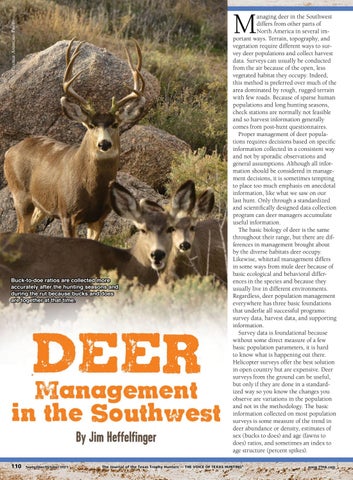George Andrejko Photo
M
Buck-to-doe ratios are collected more accurately after the hunting seasons and during the rut because bucks and does are together at that time.
110 |
September/October 2021
anaging deer in the Southwest differs from other parts of North America in several important ways. Terrain, topography, and vegetation require different ways to survey deer populations and collect harvest data. Surveys can usually be conducted from the air because of the open, less vegetated habitat they occupy. Indeed, this method is preferred over much of the area dominated by rough, rugged terrain with few roads. Because of sparse human populations and long hunting seasons, check stations are normally not feasible and so harvest information generally comes from post-hunt questionnaires. Proper management of deer populations requires decisions based on specific information collected in a consistent way and not by sporadic observations and general assumptions. Although all information should be considered in management decisions, it is sometimes tempting to place too much emphasis on anecdotal information, like what we saw on our last hunt. Only through a standardized and scientifically designed data collection program can deer managers accumulate useful information. The basic biology of deer is the same throughout their range, but there are differences in management brought about by the diverse habitats deer occupy. Likewise, whitetail management differs in some ways from mule deer because of basic ecological and behavioral differences in the species and because they usually live in different environments. Regardless, deer population management everywhere has three basic foundations that underlie all successful programs: survey data, harvest data, and supporting information. Survey data is foundational because without some direct measure of a few basic population parameters, it is hard to know what is happening out there. Helicopter surveys offer the best solution in open country but are expensive. Deer surveys from the ground can be useful, but only if they are done in a standardized way so you know the changes you observe are variations in the population and not in the methodology. The basic information collected on most population surveys is some measure of the trend in deer abundance or density, estimates of sex (bucks to does) and age (fawns to does) ratios, and sometimes an index to age structure (percent spikes).
The Journal of the Texas Trophy Hunters — THE VOICE OF TEXAS HUNTING®
www.TTHA. www. TTHA.com com









